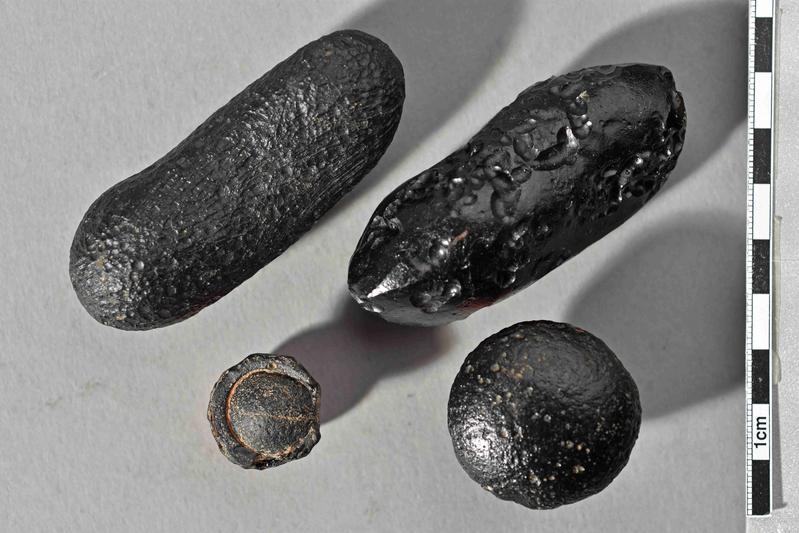

Tektites of different shapes from Australia. The force of the impact hurled the glass bodies thousands of kilometres. Some left the earth's atmosphere and acquired their flanged edge on re-entry
Approximately 790,000 years ago there were multiple cosmic impacts on earth with global consequences. Geoscientists from Heidelberg University reached this conclusion after dating so-called tektites from various parts of the world.
The research group under the direction of Prof. Dr. Mario Trieloff studied several of such rock glasses, which originated during impacts of asteroids or comets. The Heidelberg scientists employed a dating method based on naturally occurring isotopes that allowed them to date the tektites more accurately than ever.
Their studies show that the samples from Asia, Australia, Canada and Central America are virtually identical in age, although in some cases their chemistry differs markedly. This points to separate impacts that must have occurred around the same time. The results of their research funded by the Klaus Tschira Foundation were published in the journal “Geochimica et Cosmochimica Acta”.
The research group at the Institute of Earth Sciences and the Klaus Tschira Laboratory for Cosmochemistry uses isotope measurements to determine the age of craters caused by the impact of extraterrestrial rocks. “That's how we know when, where and how often projectiles struck the earth, and how big they were,” says Mario Trieloff. There have long been signs that a major event of this type took place on earth about a million years ago, according to Prof. Trieloff. This is evidenced by tektites, so-called rock glasses that arise during impact, whereby terrestrial material melts, is hurled up to several hundred kilometres and then hardens into glass.
“We have known about such tektites for some time from the Australasian region,” explains Dr. Winfried Schwarz, the study's primary author. These rock glasses form a strewn field that stretches from Indochina to the southernmost tip of Australia. Smaller tektites, known as microtektites, were also discovered in deep-sea drill cores off the coast of Madagascar and in the Antarctic. The rock glasses had been strewn over 10,000 kilometres, with some of them even leaving the earth's atmosphere. Using the 40Ar-39Ar dating method, which analyses the decay of the naturally occurring 40K isotope, the Heidelberg researchers succeeded in dating these tektites more accurately than ever before.
“Our data analysis indicates that there must have been a cosmic impact about 793,000 years ago, give or take 8,000 years,” explains Winfried Schwarz. The Heidelberg scientists also studied samples from Canada and Central America. The Canadian rock glasses had the same chemical composition and age as the Australasian tektites and could have covered similar “flight routes” as objects found in southern Australia or the Antarctic. Other finds must first confirm whether the recovery sites are really where the tektites originally landed or whether they for example were carried there by people, according to Dr. Schwarz.
The rock glasses from Central America are also tektites – the first specimens were found at Mayan sites of worship. In the meantime, hundreds of other finds have been made in Central America. “These tektites are clearly different in their chemical composition, and their geographical distribution also shows that they come from separate impacts,” explains Dr. Schwarz. “Surprisingly our age estimates prove that they originated 777,000 years ago with a deviation of 16,000 years. Within the error margin, this matches the age of the Australasian tektites.”
These findings led the Heidelberg researchers to conclude that there were multiple cosmic impacts approximately 790,000 years ago. In addition to the events in the Australasian and Central American regions, a smaller collision at around the same time created the Darwin crater in Tasmania. “The distribution of the tektites and the size of the strewn field indicate that the earth-striking body was at least a kilometre in size and released an impressive one million megatons of TNT energy within seconds of impact,” explains Dr. Schwarz.
According to the scientists, the consequences were dire. At the local level, there was fire and earthquakes for hundreds of kilometres surrounding the impact site; an ocean impact would have caused tsunamis hundreds of metres high. At the global level, dust and gases were ejected into the upper levels of the atmosphere, blocking sunlight and lowering surface temperatures. Biomass production was also affected, although according to the scientists it did not result in global mass extinction as in the case of the dinosaurs approximately 65 million years ago.
Original publication:
W. H. Schwarz, M. Trieloff, K. Bollinger, N. Gantert, V. A. Fernandes, H.-P. Meyer, H. Povenmire, E. K. Jessberger, M. Guglielmino, C. Koeberl: Coeval ages of Australasian, Central American and Western Canadian tektites reveal multiple impacts 790 ka ago. Geochimica et Cosmochimica Acta (2016), doi:10.1016/j.gca.2015.12.037
Contact:
Prof. Dr. Mario Trieloff
Institute of Earth Sciences
Phone +49 6221 54-6022
mario.trieloff@geow.uni-heidelberg.de
Communications and Marketing
Press Office
Phone +49 6221 54-2311
presse@rektorat.uni-heidelberg.de
http://www.geow.uni-heidelberg.de//forschungsgruppen/trieloff/trieloff.html












